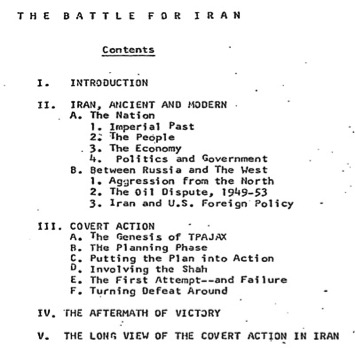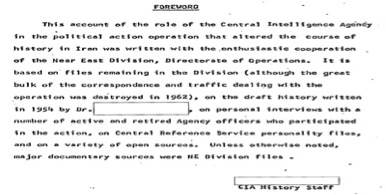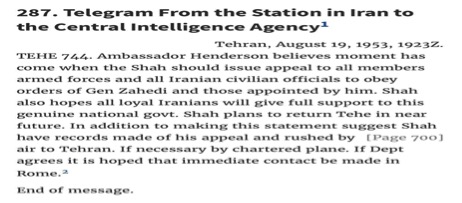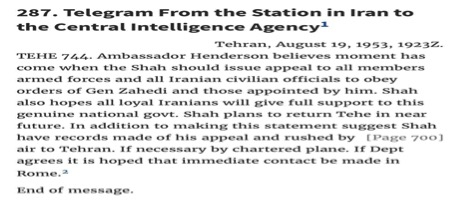The US-led coup d'etat deprived the Iranian people of democracy for 25 years. According to the section 5 of a report written by Donald Wilber, one of the main architects of the ďOperation AJAXĒ which was published in 2000, the coup d'etat was engineered by the US and the UK in which the CIA played an undeniable role[1].
The main purpose of Operation AJAX was to wipe out the communist party in Iran and overthrow the government of Mohammad Mosaddegh. Based on numerous reports by the US embassy in Iran and also Wilberís important report, however, Mohammadreza Pahlavi, Iranís Shah was opposed with coup d'etat against Mosaddeghís government. He reportedly believed that Mosaddegh had been elected by the parliament and should have been removed by the parliament. The US, however, directly took measures and carried out the coup d'etat. American democrats who wanted Iran to remain on the Westís side, but the Republican Eisenhower who came into power in the January of 1953 considered overthrowing Mosaddegh the only solution for the problem of oil under the influence of the Britain[2].
Iranís inflexible approach that considered every proposal only within the framework of nationalizing oil industry played a role in the change in the US policy. Despite Mosaddeghís willingness to compromise, however, the US government abandoned its conciliatory policy and pursued Britainís approach of toppling Mosaddegh to resolve the issue of oil, carrying out coup under the pretext of blocking the influence of communism in Iran. The Tudeh Party of Iran started its activities under the support of the former Soviet Union at the end of 1940. Its influence, however, was not as widespread or dangerous as the US claimed. The Tudeh Party did not have enough power to gain an official post. Itís noteworthy that concern over communistsí coming into power was mostly expressed by high-ranking political and intelligence officials of the United States[3].
The US Secretary of State said in a press conference on June 29 that, ďThe increase in the activities of the unlawful party of Tuden in Iran and the tolerance of the Iranian government towards the activities of this party has caused concern for the US[4], making the US help to Iran more problematic[5].Ē According to CIA documents, ďCurrently Tudeh is not considered a serious threat for the government and will not be able to take the power in 1954 even if it forms alliances with other parties and groups; However, it will be able to carry out attacks and commit terrorism[6].Ē
At that time no reason and argument could stop the US government that has always sacrificed democracy and human rights for its national interests and finally the overthrow of Mosaddegh was put on agenda by Eisenhower and CIA chief Dulles[7]. In March 1953 UK Foreign Secretary Robert Anthony Eden made a visit to the US to meet with the US secretary of state which resulted in the overthrow of Mosaddegh. During the first meeting which was held in June 1953 in the office of the US secretary of state, the final decision to overthrow the government of Iran was made and Kermit Roosevelt was chosen as the commander of the operation. Washington even ignored the warnings of the National Security Council.
On March 4 the National Security Council announced that the US must distinguish its stances from those of the UK and pay a 100-million-dollar loan to Iran. One week after Mosaddegh withdrew from oil negotiations, Eden asked Dulles not to help Tehran and Eisenhower changed his stance, announcing that such unilateral approach by the US would almost certainly have no effect. The CIA was commissioned with planning the coup and the decision was communicated to US ambassador to Iran Henderson as well as the CIA operative in Iran. One million dollars was deposited to the CIA station in Iran to be used for overthrowing Mosaddegh[8].
Although the Coup was originally engineered and carried out by the UK government, the US played an influential and key role in its implementation. Perhaps the Coup would not have succeeded without the help of the US. Itís noteworthy that one of the most important roles of the US was funding the Coup. Roosevelt said in an interview with Los Angeles Time that ďone million dollars was at our disposal for arranging popular protests to overthrow Mosaddegh that led to the death of 300 people. Almost $75000 was spent and the rest was put in a safe to be handed over to Shah.Ē Roosevelt revealed during the interview that the $75000 was given to a network of three Americans and five Iranians who were cooperating with him[9].
Documents on Washingtonís role in 1953 Coup against Mosddegh that was published by the US Department of State include confidential communications between the US embassy in Tehran and the Department of State which reveals Washingtonís direct role in engineering the Coup and overthrowing Mosaddegh. The collection includes 375 documents that demonstrate the US played a crucial role in toppling Mosaddegh government and supporting the government of Ardeshir Zahedi, the head of putschists. According to these documents, Washington planned and engineered the coup.
These documents have been organized in four main sections including ďThe US efforts to understand Mosaddegh from February 1951 to February 1952Ē, ďJuly 1952 political crisis in Iran and its consequences,Ē ďPlanning and putting AJAX operation into action in August 1953,Ē and ďAftermath of AJAX operation from September 1953 to September 1954.Ē


In one of the documents, the link between CIA and the US envoy in Tehran refers to the impending success of the coup, asking the US government for a 5-million-dollar loan to Zahediís government. The documents can be accessed in the bellow link:
http://www2.gwu.edu/~nsarchiv/NSAEBB/NSAEBB476

........................................................................................................................................................................................
[1].Countercoup; the struggle for control of Iran/, McGraw-Hill; First Edition, August,1979.
[2]. Movahed, Mohammad Ali. Agitated Oil Dream, karnameh, Tehran, 2003, pp 778-789
[3] . Gasiorowski, Mark. Mohammad Mosaddeq and the 1953 Coup in Iran (Modern Intellectual and Political History of the Middle East), Ali Morshedzadeh (trans), Ghasideh Sara, p 256
[4] . US foreign relations documents, p 1090
[5] Gasiorowski, Mark. Mohammad Mosaddeq and the 1953 Coup in Iran (Modern Intellectual and Political History of the Middle East), Ali Morshedzadeh (trans), Ghasideh Sara, p 256
[6] . . US foreign relations documents, p 1163
[7] . The Study of the Behavior of the US, Tehran, Center of Islamic Revolution Documents, 2008, p 170
[8] . US foreign relations documents, p 1095
[9] . Mosely, Leonard. Power Play: Oil in the Middle East, 1973











